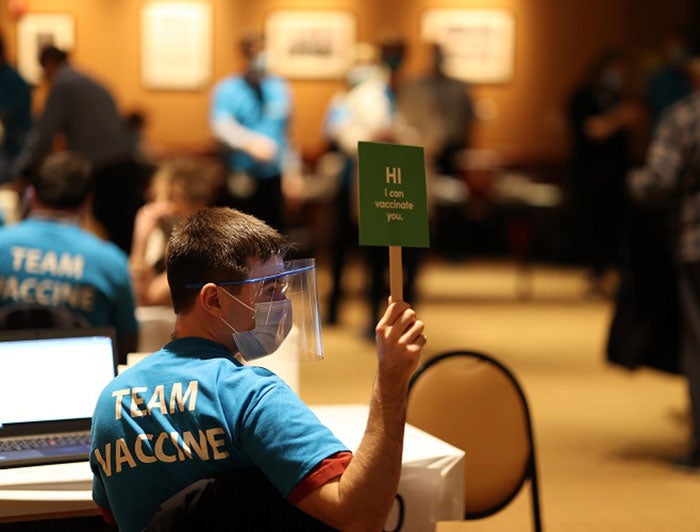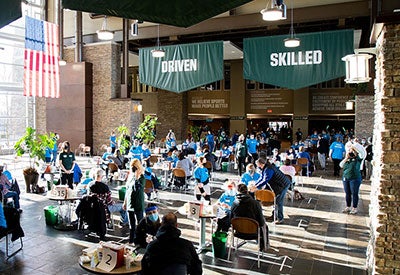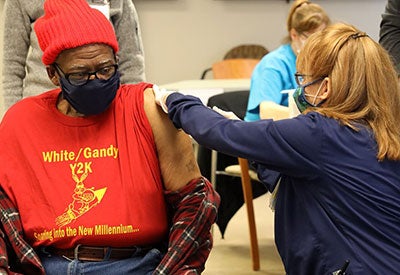Allegheny Health Network Strives for an Equitable Vaccine Rollout
AtlantiCare relies on efficient and effective collaboration and communication to vaccinate communities.

Photos courtesy of Allegheny Health Network
Allegheny Health Network’s (AHN) public vaccination campaign kicked off in mid-January of this year, when it began vaccinating patients ages 75 and older. Yet health system leaders and front-line staff began planning for the public health campaign in December 2020, when the Food and Drug Administration advisory panel recommended both the Pfizer-BioNTech and Moderna vaccines for emergency use. That’s also when the health system began vaccinating its own employees, providing more than 32,000 COVID-19 vaccine doses to health care professionals and emergency medical services providers throughout Western Pennsylvania. Six months later, more than 12 million vaccine doses have been administered and more than 40% of the Pennsylvania population has been fully vaccinated.
The Approach
AHN’s philosophy was to ensure equitable distribution of vaccine to all people within Western Pennsylvania, and to develop strategies to increase distribution as supply became available, scaling the operation to reach as many people as possible. Like all health systems, AHN initially focused its outreach on older, higher-risk populations. The health system followed the state of Pennsylvania’s guidance regarding which groups were part of that high-risk cohort, while also placing special emphasis on vaccine distribution equity. AHN directed 20% or more of all vaccine doses to minority patients and traditionally underserved geographies reflecting the population demographics of the region.
AHN knew early on that the fastest way to get shots into arms of eligible people was through large-scale vaccination events, given the space and throughput limitations of hospitals and outpatient clinics. AHN began scouting for locations across its geographic footprint, which includes all of Western Pennsylvania. Focus was placed on major regions, such as Pittsburgh and Erie. The goal was to operationalize and standardize the clinics — and the human resources needed to operate them — so that AHN could accommodate 7,500 to 8,000 patients a day, if necessary.

The first location identified was PNC Park, home of the Pittsburgh Pirates baseball team, one of AHN’s corporate partners. On Saturday, Feb. 6, AHN hosted the first of what would be multiple large-scale vaccination events at PNC Park over the ensuing months.
Future locations for large-scale events included convention centers, DICK’s Sporting Goods corporate headquarters, and suburban shopping malls. AHN strategically positioned mass vaccination clinics around the region to reduce long travel times. Implementing this high-capacity system early on allowed AHN to continue to receive large amounts of vaccine supply from the state. Smaller vaccination events took place at fire departments, churches, high schools, universities and high-rise retirement communities.
Marginalized populations or patients who rank high on the Centers for Disease Control and Prevention’s Social Vulnerability Index were reached through specialized, invitation-only and walk-in clinics. AHN used data from its information technology system and affiliated health plan, Highmark Inc., to identify people with limited access and partnered with local churches, the African-American Chamber of Commerce, Latino Chamber of Commerce, Asian community leaders, special needs organizations, homeless shelters and jails to set up vaccine events.
As the vaccine authorization extends to teens and adolescents, AHN is focusing greater emphasis on school-age cohorts and developing “family friendly” and “after school” events where entire families can go to be vaccinated together.
Key to the health system’s vaccine rollout plan was the development of a triad model with leaders from AHN’s pharmacy department, operations team and physician leadership team. Additionally, a steering committee was formed to provide additional support and expertise. The steering committee included representatives from across the organization including nursing, operational excellence, IT, marketing, communications, clinical access, human resources, data analytics, regulatory, revenue cycle, compliance, security, community affairs, diversity and inclusion, primary care institute and pre-hospital care services.
Educational and thought leadership videos also played a key role in encouraging people to get vaccinated. A video highlighting the health system’s vaccine rollout plan featured top leadership and patients. Another video shared the vaccine experience, offering people a tour of a vaccination site.
Results
By mid-May 2021, AHN had administered 350,000 Pfizer-BioNTech, Moderna and Johnson & Johnson vaccine doses to approximately 200,000 individual patients. Approximately 17% of all of AHN’s vaccine doses have been administered to patients who self-identify as being part of a minority group.

Beyond patient health implications, the success of AHN’s COVID-19 vaccination campaign has had a positive impact on its public reputation. Of those who were vaccinated at an AHN event and responded to a subsequent survey, 98% said they would consider using AHN for other services in the future. The public response to the AHN vaccination effort — and to the events — was overwhelmingly positive and generated an enormous amount of goodwill and trust for the health network.
AHN is working to ensure that the organizational goodwill translates into better patient relationships, better continuity of care and better sight lines into disadvantaged communities. The health system is presently reaching out to all patients who have been vaccinated at AHN to provide additional information regarding post-vaccination practices and to address other questions they may have.
Additionally, AHN is now reaching out to new patients – about 64,000 of them – who were introduced to the network through its vaccination efforts.
Lessons Learned
- Participating in — and in many ways leading — Western Pennsylvania’s first large-scale public health campaign since the polio vaccine drives of the late 1950s presented innumerable logistical challenges. The first was in the design of the mass events. First, AHN’s community affairs and operations teams worked hard to identify partners and venues that would be a good fit and help the health system meet equitable distribution goals.
- Once AHN identified venues, the operation team mapped out every step of the process, modeled the optimal throughput and staged the dry runs that preceded the actual vaccination events. AHN modeled different times for different cohorts. For example, the 75-and-older populations would take longer to move through the various stations than younger, more mobile patients.
- Community partnerships matter. AHN partnered with local businesses, education institutions, government organizations, churches and community groups. The partners pitched in through a wide range of activities, from supplying a small army of volunteers who assisted with wayfinding, greeting patients, parking and escorting patients to and from their cars, to setting up and tearing down the pop-up vaccine clinics. Partners also helped to promote the vaccine events, distribute educational materials and schedule vaccinations.
- Attitude and environment matter. AHN created a pep-rally style atmosphere at its vaccine events with cheer squads, music, free snacks and other giveaways. For all patients — especially high-risk, older adult patients who hadn’t left their homes in months — it was an uplifting, emotional experience.
- Sustaining the momentum of early events — and the excitement surrounding them — might have been AHN’s biggest challenge. Each large event required as many as 160 volunteers on site. By mid-March 2021, AHN was staging multiple vaccine events a week, calling on hundreds of employees and volunteers each week to help. AHN enlisted nurses, IT professionals, pharmacists and others from throughout the system, including from outpatient campuses and corporate headquarters. AHN also enlisted the help of medical students and nursing students who, under clinical supervision, assisted with vaccinations. It was an incredible lift, and it was critical that every person who was pulled from a clinical location to work at a vaccine event was accounted for by human resources and backfilled.
- Sustaining organizational momentum and mitigating vaccine fatigue also was a challenge. And it required the full support of the health system’s top leadership. David Holmberg, chief executive officer, Highmark Health, the parent company of AHN; Cindy Hundorfean, chief executive officer, AHN; and other top executives attended dozens of vaccine events. Their commitment was not performative; they genuinely wanted to serve and do their part to pitch in. They made it a priority to talk with patients, employees and volunteers. Their attitude was contagious and helped inspire the rest of the team.

